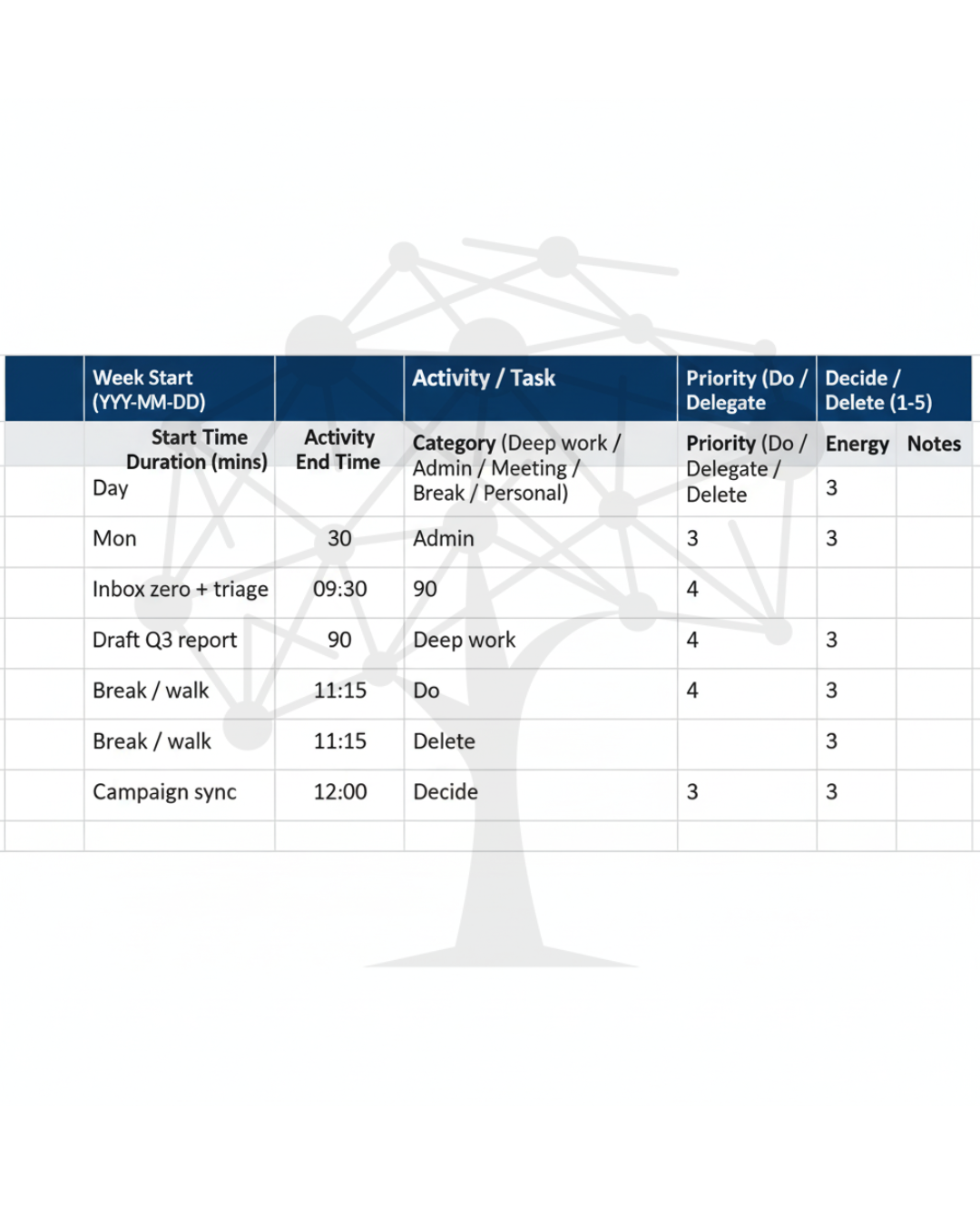
You’re not “bad at time”—you’re battling a work stack that splinters attention and buries priorities. This guide curates time management techniques that actually move the needle, built for busy professionals. Instead of dumping 25 random tips, you’ll get 10 essentials and a quick framework to choose what fits your work style. Expect 5-minute first steps, real-world examples, and a downloadable Weekly Time Audit to show where your hours really go. Let’s turn scattered effort into focused execution.
Time management techniques are structured methods for planning and controlling how long you spend on activities so you increase productivity and reduce stress by prioritizing, minimizing distractions, and scheduling your workflow intentionally.
Top 10 (quick list):
Time Blocking
Pomodoro
2-Minute Rule
Eat That Frog
Task Batching
Strategic Delegation
Automation & Apps
Weekly Review
Why You’re Busy But Not Productive (And How to Fix It)
Most of us spend more time on “work about work” (status checks, app-toggling, inbox churn) than on skilled, high-value output—coordination can eat over half the week. Attention is also under siege: average on-screen focus windows are often under a minute before we switch, and regaining context takes several minutes. The fix isn’t “work harder”—it’s a system that defends focus and directs effort to the highest-value work.
Mini-summary: Coordination overhead and micro-distractions steal your week; install a system, not heroics.
Quick check: Estimate your split: deep work vs. meetings/messaging/admin. If deep work is below 40%, redesign your week.
10 Essential Techniques (With Fast Wins)
Each method includes a 5-minute start and best-fit use cases—so you can act today.
1) Eisenhower Matrix — Prioritize What Moves the Needle
Sort tasks into Do (urgent + important), Decide/Schedule (important, not urgent), Delegate (urgent, not important), Delete (neither) to keep urgency from hijacking importance.
Start in 5 minutes: List today’s tasks; sketch a quick 2×2; place each task. Schedule Quadrant II items.
Best for: Managers and anyone drowning in competing requests.
2) Time Blocking — Turn To-Dos Into Done
Move from hopeful lists to scheduled blocks. Protect deep-work windows and batch admin into narrow lanes.
Start in 5 minutes: Block one 90-minute deep-work session tomorrow. Build the day around it.
Best for: Makers (designers, engineers, writers) and anyone with long-form work.
3) Pomodoro Technique — Hold Focus Without Burnout
Work in 25-minute focus sprints with short breaks to sustain intensity and prevent fatigue.
Start in 5 minutes: Pick one task, set a 25-minute timer, silence notifications, go. After four rounds, take a longer break.
Best for: Attention drift, interruptions, or starting friction.
4) 2-Minute Rule — Erase Micro-Clutter
From GTD: If it takes < 2 minutes, do it now. Kill friction before it snowballs.
Start in 5 minutes: Clear five quick tasks—confirm a meeting, file a receipt, rename a file, archive tabs, send that one-liner.
Best for: Inbox and small-task overload.
5) “Eat That Frog” — Ship the Highest-Impact Work Early
Tackle the single, highest-impact task first—before decision fatigue and pings pile up.
Start in 5 minutes: Write tomorrow’s “frog” on a sticky note. It’s your first calendar block.
Best for: Procrastination on hard, important work.
6) Task Batching — Slash Context Switching
Group similar work (all emails, all approvals, all reviews) to cut switching costs.
Start in 5 minutes: Choose two 20-minute email windows. Close email the rest of the time.
Best for: Communication-heavy roles and “always on” teams.
7) Parkinson’s Law — Ship Faster With Smaller Containers
Work expands to fill the time available. Shrink the container to accelerate delivery.
Start in 5 minutes: Take a 60-minute task and time-box it to 45. Ship a draft, not a masterpiece.
Best for: Perfectionism, slow-rolling projects, and analysis paralysis.
8) Strategic Delegation — Multiply Your Output
Delegation is leverage, not abdication. Define the outcome, constraints, resources, and decision rights.
Start in 5 minutes: Pick one task you shouldn’t do. Define “done,” assign an owner, and schedule a check-in.
Best for: Managers and ICs with repeatable processes.
9) Automation & Apps — Reduce Busywork
Tools should support your method—never become the method. Automate repeatables (reports, reminders), centralize tasks, and limit your app count to cut toggle-tax.
Start in 5 minutes: Automate one step (e.g., auto-label emails or set a recurring weekly review).
Best for: High repetition and cross-tool workflows.
10) Weekly Review — Keep Your System Clean and Current
A 30–60 minute weekly review keeps priorities fresh and your system trustworthy.
Start in 5 minutes: Book Friday 3:00–3:30 PM. Scan next week’s calendar, close open loops, choose your Big 3.
Best for: Everyone—this is the keystone habit.
Mini-summary: Sequence matters—prioritize (Eisenhower), schedule (Time Blocking), protect focus (Pomodoro/Batching), and recalibrate weekly (Review).
Quick check: Choose one technique and commit for 7 days. If it sticks, layer a second.
How to Choose the Right Technique (Match by Role + Bottleneck)
Match method to work type. Makers thrive with Time Blocking + Pomodoro for deep work. Managers win with Eisenhower + Batching + Delegation to tame interrupts.
Run a 3-day time audit. Track how long tasks take, when your energy spikes, and which interrupts recur. Then choose the technique that targets your bottleneck (attention drift → Pomodoro; prioritization fog → Eisenhower; throughput limits → Delegation).
Mini case: A marketing manager juggling three campaigns consolidated pings into a daily “comms hour,” scheduled Quadrant II strategy blocks, and added a Friday Weekly Review. Result: two extra 90-minute deep-work blocks per week.
Why New Systems Fail (And How to Prevent It)
Common pitfalls: Perfectionism Paralysis (tinkering with tools instead of doing work), Weak Block Defense (letting low-value urgencies invade), and Tool Overload (choosing an app before a simple process). Keep the stack light and rules clear.
Build a Minimal Productivity Stack
Weekly Review (Fri): Clear inboxes, pick next week’s Big 3.
Eisenhower (Mon): Slot new tasks into quadrants.
Time Blocking (Daily): Put Do/Decide tasks on the calendar and defend the blocks.
Mini-summary: Pick by role and bottleneck; compose a lean, repeatable stack.
Quick check: Audit for 3 days → pick 1 method → review after a week. If deep-work hours are under 6 per week, adjust.
Start Taking Control of Your Time Today
Mastering time is the highest-leverage move in your career. Measure reality, then install one method and defend it. Your next best step is simple.
You don’t need 25 tips—you need the right few that fit your role and bottlenecks. Prioritize with Eisenhower, schedule with Time Blocking, protect attention with Pomodoro/Batching, and recalibrate weekly. Measure, adapt, and keep the system light.

☝️Take one action now: Download the Weekly Time Audit Template and log your next three workdays. Your data will point to the time management techniques that will win back your week.
Quick Beneficial Course: Time Management Course
Frequently Asked Questions
What is the most effective time management technique?
There’s no single “best.” A strong starter combo is Eisenhower Matrix (clarify priorities) + Time Blocking (protect them on your calendar).
How can I improve my time management skills quickly?
Run a time audit for 2–3 days, then try Pomodoro or the 2-Minute Rule for one week—small, consistent changes compound.
What are the 4 D’s of time management?
From the Eisenhower Matrix: Do, Decide/Schedule, Delegate, Delete.
Why is time management important for success?
It increases throughput, reduces stress, and improves decision quality by focusing energy on high-value work.
What is the 80/20 rule in time management?
The Pareto Principle: a minority of activities produce a majority of results—identify the critical 20% and schedule it first.
What's the best tip for managing my work-life balance?
Set clear boundaries and stick to them. Define work hours and avoid checking notifications or emails outside of that time. Schedule blocks for hobbies and personal time, treating non-work activities like essential appointments on your calendar.
